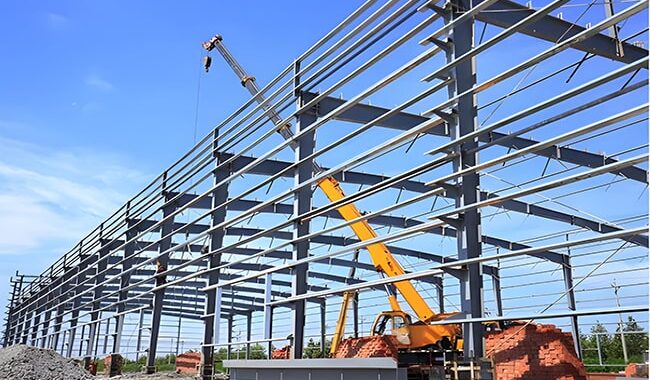In the construction of modern storage facilities, steel structure warehouses have become one of the mainstream building forms due to…
At this stage, no metal material can be guaranteed to be permanently rust-proof, even the steel structure, known for its rust-proof solid ability. Therefore, to extend the service life of the steel structure, we must take some rust removal measures. The following article shares steel structure rust removal methods and grade requirements.

Methods for steel structure rust removal:
Shot blasting:
It is a method that uses the high-speed operation of mechanical equipment to throw steel shots of a specific size by the centrifugal force of the throwing head. The thrown steel shots violently collide with the components to achieve the purpose of removing corrosion on the steel surface.
The types of steel Shot it uses are cast iron shot and steel wire cut shot. Cast iron shot is formed by spraying molten iron and rapidly cooling it, with a particle size of 2 to 3 mm and a very round surface. The cost is relatively cheap, but the durability is slightly poor. During the shot blasting process, the iron pellets are crushed and discharged as dust after repeated impacts.

Steel wire cut pills are made from scrap steel wire ropes cut into 2mm segments. Its surface has sharp corners. It has a relatively high rust removal effect and is not easy to break. It has a longer service life, but the price has increased. The shot-blasting surface of the latter is rougher.
Shot peening:
A steel structure rust removal method that uses high-pressure air to bring out steel shots and spray them onto the surface of the component.
Sandblasting:
A steel structure rust removal method that uses high-pressure air to bring out quartz sand and spray it onto the surface of the component. The sources of quartz sand include river sand, sea sand, and artificial sand. Sand is cheap and widely available, but it pollutes the environment significantly; rust removal is entirely manual. The surface roughness of the components after rust removal is slight, and it is challenging to meet the friction coefficient requirements. Sea sand should be desalted before use.
Steel structure rust removal methods for Shot peening and Sandblasting require the ambient humidity to be less than 85%.
Pickling:
Pickling rust removal is also called chemical rust removal. Its principle is to use the acid in the pickling solution to chemically react with metal oxides to dissolve them and remove rust and dirt on the steel surface. However, pickling cannot achieve the surface roughness effect of shot blasting or peening.
After pickling and rust removal, a large amount of clean water must be used for cleaning and passivation treatment; a large amount of wastewater, waste acid, and acid mist formed will cause environmental pollution. If not handled properly, the metal surface will be corroded and pitted. Currently rarely used.

Manual and power rust removal:
The tools are simple and convenient for construction, but the labor intensity is high, and the quality of rust removal is poor. This method can only be used locally under conditions where other methods are not available, such as the trimming of individual components or local rust removal at the installation site.
Commonly used tools include grinder, blade, wire brush, emery cloth, etc.
Steel structure Rust removal level
The national standard GB8923-88 “Steel Surface Modification Level and Rust Removal Level before Painting” divides the rust removal levels into three types: spray or projectile rust removal, manual and power rust removal, and flame rust removal:
Spray or projectile rust removal is represented by the letter “Sa.” There are four levels:
Steel structure rust removal: Sa1 mild spray or blast.
There is no visible grease or dirt on the surface of the steel, and there are no attachments such as scale, rust, and paint coatings that are not firmly attached.
Steel structure rust removal: Sa2 thoroughly sprays or blasts away rust.
There should be no visible grease, dirt, oxide scale, rust, or other attachments on the steel surface, and the residues should be firmly attached. The projection dents formed after shot blasting are evenly arranged on the surface of the steel, and the anti-slip coefficient reaches 0.35 to 0.45.
Steel structure rust removal: Sa2.5 very thoroughly sprays or blasts away rust.
The steel surface should be free of visible grease, dirt, scale, rust, paint coatings, and other attachments, and any remaining traces should be only dots or strips of slight stains. The projection dents formed after shot blasting are evenly arranged on the steel surface, and the anti-slip coefficient reaches 0.45 to 0.5.
Steel structure rust removal: Sa3 spray or projectile rust removal to make steel appear clean.
The steel surface should be free of visible grease, dirt, scale, rust, paint, and other attachments, and the surface should show a uniform metallic luster.
Manual and power rust removal: represented by the letters “St” and divided into two levels:
St2 thorough hand and power rust removal.
The steel surface has no visible grease, dirt, and no attachments such as oxide scale, rust, and paint coating that are not firmly attached.
St3 is very thorough in hand and power rust removal.
There should be no visible grease or dirt on the steel surface. And there are no attachments such as scale, rust, and paint coating that are not firmly attached. Rust removal is more thorough than St2, and the surface of the exposed part of the substrate should have a metallic luster.
Flame rust removal, represented by the letter “F1”,
It involves using a power wire brush to remove the heating products attached to the steel surface after the flame heating operation.
There is only one grade: the F1 steel surface should be free of scale, rust, paint coating, and other attachments, and any remaining traces should only be surface discoloration.














